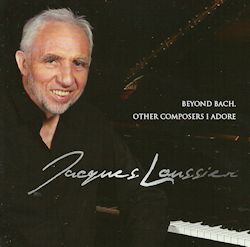CD 1
1. Vivaldi: Concerto No. 2 in G minor, “Summer”: Allegro con molto
2. Vivaldi: Concerto No. 2 in G minor, “Summer”: Adagio
3. Vivaldi: Concerto No. 2 in G minor, “Summer”: Presto
4. Satie: Gymnopedie No. 1, Variation 1
5. Satie: Gnossienne No. 1
6. Handel: Passacaglia
7. Scarlatti: Sonata No. 33 in B minor
8. Ravel: Boléro
9. Debussy: Clair de lune
10. Debussy: Arabesque
Jacques Loussier – Piano
Vincent Charbonnier – Bass (tracks 1-3)
Benoit Dunoyer DeSegonzac – Bass (tracks 4-10)
André Arpino - Drums
CD 2
1. Beethoven: Allegretto from Symphony No. 7: Theme
2. Beethoven: Allegretto from Symphony No. 7: Variation 2
3. Beethoven: Allegretto from Symphony No. 7: Variation 5
4. Mozart: Concerto No. 23 in A major: Allegro
5. Mozart: Concerto No. 23 in A major: Adagio
6. Mozart: Concerto No. 23 in A major: Allegro assai
7. Schumann: Of Foreign Lands and Peoples
8. Schumann: Dreaming
9. Chopin: Nocturne No. 5
10. Chopin: Nocturne No. 11
11. Chopin: Nocturne No. 14
12. Chopin: Nocturne No. 20
Jacques Loussier – Piano
Benoit Dunoyer DeSegonzac - Bass (tracks 1-8)
André Arpino – Drums (tracks 1-8)
“Jazzing the Classics” has been a fruitful genre for nearly 100 years – since I’m Always Chasing Rainbows stole a tune from Chopin in 1918, and Avalon adapted Puccini in 1920. Jacques Loussier has been jazzing the classics since 1959. But Loussier’s modifications of classical music have
been less drastic than most other pilferings from the classics. Incidentally, I must question the statement in Alyn Shipton’s sleeve-notes that the
barriers between jazz and the classics were broken down “almost entirely due to the work of one man, the French pianist Jacques Loussier”. Shipton’s own New History of Jazz mentions several earlier artists who blended jazz with classical music – from Eddie Sauter to John Lewis, and from Bill Russo
to Gunther Schuller.
This double CD is one of two released to celebrate Loussier’s 80th birthday. The first one samples Jacques’ adaptations of music by Bach, the
composer with which he first made his name. But from the 1990s he experimented with other composers, and the second album (which we are dealing with here)
illustrates his work with ten of these.
The first CD opens with Vivaldi’s well-known portrayal, of Summer from The Four Seasons, which Loussier adapts fairly freely, delaying the shift
into Allegro and instead playing something that sounds like John Lewis’s Django. As so often in Loussier’s recordings, he tends only to provide
small elements of jazz. He generally starts by playing a piece straightforwardly and only after a while does he jazz it up very slightly. In the final
movement, Jacques manages to convey the feeling of a storm that Vivaldi wrote into his concerto, with some vigorous playing from the whole trio. But the
jazz content is sparing rather than assertive.
Satie’s Gnossienne No. 1 goes into a bossa nova beat for a while. The pieces by Handel and Scarlatti take us back to the style of Loussier’s
adaptations of Bach. Again, Handel’s Passacaglia includes echoes of the MJQ’s Django. At 17 minutes, Ravel’s Boléro is
the longest track on the album but it fatally loses the work’s innate excitement by interrupting the crescendo and dispensing with Ravel’s thrilling rhythm
in exchange for a dull two-in-the-bar. It eventually moves into four-four but it is far too polite. In the press release, Loussier refers to the piece’s
“constant crescendo” but he allows the bass and drums to break up the continuity.
The first track of the second CD is a straight transcription of a movement from Beethoven’s 7th Symphony. The plodding drums are too dense and
the attempts at a jazz rhythm are awkward. The third track puts a Latin beat behind the theme to liven it up a bit.
In the Mozart concerto the trio is accompanied by an uncredited string orchestra. This is played well enough, although Loussier surprisingly lacks the
delicacy of touch that some pianists bring to Mozart. Schumann’s Of Foreign Lands and Peoples is speeded up considerably, almost turning it into
jazz-rock. Finally Jacques interprets Chopin entirely on his own. Nocturne No. 5 is played as if it is ragtime. In a way, these Chopin pieces suit
Loussier well, as he clearly enjoys performing most of them with consideration for Chopin’s original style.
Attractive as many of Loussier’s recordings are, he tends to keep to a classical style of rhythm – firmly on the beat – which suggests that, because he
started as a classical pianist, he retains its habits even when he improvises jazz. The result is that the music seldom swings and it lacks the sound of
surprise which is a hallmark of good jazz. Loussier’s interpretations may be a form of jazz, but it’s jazz lite.
Tony Augarde
www.augardebooks.co.uk
